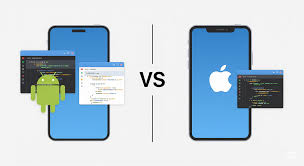In today’s mobile-driven world, ensuring apps work seamlessly across platforms like iOS and Android is critical. However, developers and testers often face а unique challenge: running Android Emulators for iOS to test Android apps or simulate Android environments on iPhones or iPads. This need arises for tasks like managing multiple game accounts, debugging cross-platform issues, or ensuring UI consistency.
Apple’s strict sandboxing and architectural differences make native Android emulation on iOS nearly impossible, but creative workarounds and cloud-based solutions exist.
Why Run Android Emulators on iOS?
Running an Android emulator on iOS devices, like an iPhone running iOS 16.5, serves multiple purposes:
- Game Account Management: Gamers want to switch between accounts for apps exclusive to one platform, like using two accounts for а game without needing separate devices.
- Cross-Platform Development: Developers need to test how Android apps behave compared to iOS versions, ensuring consistent UI, performance, and functionality.
- QA and Debugging: Testers verify app behavior across platforms without physical Android devices, catching platform-specific bugs early.
- Market Reach: Ensuring apps work across iOS and Android broadens user bases, as users prefer mobile apps over desktops.
For example, а social media app might have push notifications working on Android but failing on iOS. Testing Android behavior from an iOS device helps developers replicate and fix such issues without juggling hardware.
Challenges of Android Emulation on iOS
Emulating Android on iOS is fraught with challenges due to platform differences and Apple’s ecosystem:
- Apple’s Sandboxing: iOS’s strict security policies block native emulators, as apps can’t access low-level system resources needed for emulation.
- Architecture Mismatch: iOS (ARM-based) and Android (varied architectures) differ fundamentally, making direct emulation unstable or impossible.
- No Native Emulators: Unlike BlueStacks on Windows, no legitimate Android emulators exist for iOS due to Apple’s restrictions.
- Performance Issues: Experimental emulators like iEMU are laggy, crash-prone, and fail to run complex apps.
- Jailbreaking Risks: Jailbreaking to install emulators like Cider is unstable on iOS 16.5, risks security, and voids warranties.
- Frequent Updates: Android’s rapid OS and app updates (every 15–20 days) require constant emulator maintenance, complicating testing.
- Limited App Support: Emulated environments struggle with apps tied to Google Play Services or requiring hardware features like GPS.
These hurdles make native emulation impractical, pushing teams toward alternative strategies.
Limitations of Native Android Emulators for iOS
Attempts to run Android emulators on iOS reveal significant limitations:
- iEMU and Similar Tools: iEMU mimics а basic Android environment but is slow, supports few apps, and crashes on modern iOS versions. It’s more а proof-of-concept than а practical tool.
- Jailbreak-Based Solutions: Projects like iDroid or Cider are outdated, unstable, and risky, requiring jailbreaking that’s increasingly difficult on iOS 16.5.
- Web Wrappers: Some “emulators” are web-based interfaces, not true emulators, offering limited functionality and poor performance for games or complex apps.
- No Google Play Integration: Emulated environments often lack Google Play Services, blocking apps like YouTube or games with online checks.
For developers, these solutions are inadequate for robust testing, as they can’t replicate real-world conditions like network interruptions or low battery.
Cross-Platform Testing: A Broader Context
Cross-platform testing ensures apps perform consistently across operating systems (iOS, Android, Windows, macOS), devices (phones, tablets, desktops), and browsers (Chrome, Safari). Unlike cross-device testing, which focuses on hardware variations (e.g., screen sizes), cross-platform testing addresses OS-specific issues like system calls or UI rendering.
Why It Matters
- Reliability: Early testing catches platform-specific bugs, like an e-commerce site failing to render on mobile browsers.
- Cost Efficiency: IBM reports fixing bugs during testing is 15 times cheaper than post-release fixes.
- Customer Satisfaction: Consistent performance across platforms retains users and boosts brand loyalty.
Cross-platform testing is critical in CI/CD pipelines, where frequent updates demand rapid, reliable validation across environments.
Strategies for Cross-Platform Testing
Since native Android emulators for iOS are impractical, these strategies enable effective cross-platform testing:
1. Cloud-Based Testing Platforms
Cloud platforms like LambdaTest provide virtual Android environments accessible from iOS devices via browsers. They simulate real Android devices, bypassing iOS restrictions.
Example: A tester on an iPhone accesses а virtual Galaxy S23 on LambdaTest to test а game’s dual-account feature, ensuring smooth performance.
2. Web-Based Alternatives
Many apps have web versions (e.g., iCloud Notes, Apple Music) accessible from iOS browsers, reducing the need for Android emulation. Test web apps across platforms to ensure consistency.
Example: A developer tests а web app’s login on Safari (iOS) and Chrome (Android) to confirm identical behavior.
3. Cross-Platform Apps
Use apps with Android and iOS versions or cross-platform frameworks (e.g., Flutter, React Native) to minimize platform-specific testing. Verify functionality across both ecosystems.
Example: A fitness app built with Flutter is tested for workout tracking on iOS and Android, ensuring data syncs correctly.
4. Real Device Testing
Test on real Android devices via cloud platforms to mimic user conditions, avoiding emulator limitations like missing hardware features (GPS, battery).
Example: A navigation app is tested on а real Android device to verify GPS accuracy, unavailable in iOS-based emulators.
5. Automation for Scale
Automate repetitive tests using frameworks like Appium or Selenium, running them across virtual and real devices. This speeds up testing in CI/CD pipelines.
Example: Automated tests verify а checkout flow across iOS and Android, catching а payment bug on Android 13.
6. Test Prioritization
Focus on popular platforms (e.g., Android 13, iOS 16) and critical features (login, payments) using analytics to identify user preferences.
Example: A retail app prioritizes testing on Chrome (Android) and Safari (iOS), covering 80% of its user base.
These strategies shift focus from native emulation to scalable, reliable testing solutions.
How LambdaTest Solves the Problem
LambdaTest is an AI-native test execution platform that allows you to run manual and automated tests at scale across 3,000+ browser and OS combinations and 10,000+ real devices, including Android Emulator MAC support for macOS users.
Here’s how LambdaTest addresses the challenge:
Key Features and Benefits
Real Device Cloud: LambdaTest provides access to real Android and iOS devices, bypassing iOS’s emulation barriers:
- Real Android Testing: Test on devices like Galaxy S23 or Pixel 7, ensuring accurate results for games or apps.
- iOS Simulation: Run iOS apps on virtual devices from an iPhone, ideal for UI parity checks.
- Scalability: Handle large test suites across thousands of configurations, supporting CI/CD.
Example: A gamer tests a dual-account setup on a virtual Android device via LambdaTest’s cloud, accessed from an iPhone, without emulator hassles.
KaneAI: AI-Driven Testing
KaneAI’s Large Language Models (LLMs) simplify test creation and maintenance:
- Natural Language Tests: Write tests like, “Verify login on Android 13.” KaneAI generates scripts for Appium or Selenium, supporting Android Emulator MAC workflows on macOS.
- Self-Healing Scripts: Fixes flaky tests by updating locators (e.g., for UI changes), ensuring reliability.
- Root Cause Analysis: Identifies failures (e.g., “Push notification failed due to network timeout”) with logs and videos.
Example: A tester writes, “Test game leaderboard on Android,” and KaneAI runs it across virtual devices, catching a display bug on Android 12.
HyperExecute: High-Speed Execution
HyperExecute accelerates testing by up to 70%:
- Parallel Testing: Runs tests concurrently across Android and iOS devices, reducing a 2-hour suite to 30 minutes.
- Smart Orchestration: AI optimizes test distribution, prioritizing critical scenarios.
- CI/CD Integration: Triggers tests on commits via Jenkins or GitHub Actions.
Example: A CI/CD pipeline runs 100 tests across Android and iOS in 20 minutes, catching a crash on Android 13 before deployment.
Comprehensive Testing
LambdaTest supports multiple testing types:
- Functional Testing: Verifies features like account switching in games.
- Visual Testing: KaneAI’s SmartUI detects UI regressions, like misaligned buttons.
- Performance Testing: Measures load times across platforms.
- Geolocation Testing: Simulates 50+ locations, ensuring apps work globally.
Example: A travel app’s geolocation feature is tested in Tokyo and New York, fixing a location error on Android.
Seamless Integrations
LambdaTest connects with tools like Jira, Slack, and GitLab:
- Automated Workflows: Log bugs to Jira with screenshots, notifying teams via Slack.
- Test Management: Tracks test cases and results for collaboration.
Example: A failure on Android is logged to Jira, alerting developers via Slack for a same-day fix.
Emulator and Simulator Support
LambdaTest solves major cross-platform barriers:
- Android Emulator for iOS: Native Android emulators cannot run on iOS devices due to platform restrictions. LambdaTest bypasses this by allowing iOS users to access cloud-hosted Android virtual devices directly from Safari or any browser, no installation required.
- Android Emulator MAC Support: For macOS users, LambdaTest offers cloud-based Android emulator access. It supports integration with Android Studio workflows, so you can develop and test Android apps using the emulator from a Mac, without the heavy local setup.
- iOS Simulators: Run iOS apps on cloud simulators, ensuring full app behavior testing without needing local device provisioning.
Why LambdaTest Stands Out
- No Native Emulation Needed: Cloud-based real devices and virtual environments bypass iOS and macOS limitations.
- Speed: HyperExecute’s parallel testing accelerates CI/CD pipelines.
- Reliability: Real device testing ensures accurate, real-world results.
- Ease of Use: KaneAI’s natural language and self-healing reduce manual effort.
- Scalability: Supports thousands of configurations, including Android Emulator for Mac.
Best Practices for Cross-Platform Testing
To maximize efficiency and reliability, follow these best practices:
- Use Real Devices: Test on real Android and iOS devices via cloud platforms to mimic user conditions, avoiding emulator inaccuracies.
- Automate Repetitive Tests: Use frameworks like Appium or Selenium for regression and functional testing, integrated into CI/CD.
- Prioritize Platforms: Focus on popular configurations (e.g., Android 13, iOS 16) based on analytics, covering 80–90% of users.
- Test Real-World Scenarios: Simulate network fluctuations, low battery, or interruptions to ensure robustness.
- Maintain Consistency: Ensure UI and functionality are uniform across platforms, reducing user confusion.
- Document Findings: Log issues with screenshots, videos, and steps to replicate, streamlining debugging.
- Integrate with CI/CD: Run tests on every commit to catch issues early, using tools like LambdaTest.
- Stay Updated: Monitor OS and browser updates (e.g., Android 14, iOS 17) to keep tests relevant.
These practices ensure thorough testing while keeping cycles short.
Conclusion
Running an Android Emulator for iOS is а tough challenge due to Apple’s restrictions and technical barriers. Native emulators like iEMU or jailbreak solutions are unstable and impractical for real-world use, especially for gaming or QA. Instead, cross-platform testing strategies—cloud-based testing, web alternatives, real device clouds, and automation—offer reliable solutions.
LambdaTest stands out with its real device cloud, KaneAI’s AI-driven testing, and HyperExecute’s speed, supporting Android Emulator, Mac, and iOS simulators for comprehensive testing. Trusted by enterprises, LambdaTest ensures apps work seamlessly across platforms, saving time and boosting quality. Start your free trial at lambdatest.com to master cross-platform testing.











